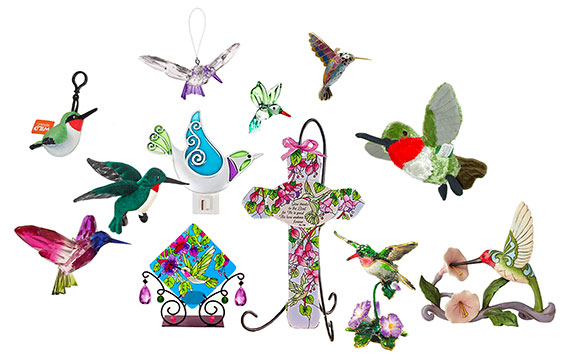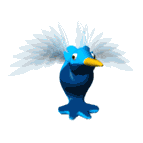


Learn all about the Hummingbird, and find hummingbird gifts, here in the Aviary at the Forest Cottage.
Hummingbirds are like little flying jewels. They are the subject of many fine gifts, such as those shown above. You can find these beautiful hummingbird products and plush toys at our sponsor's online gift shop. Find Hummingbird gifts at our sponsor's online gift shop: www.jeanniescottage.com.
The Hummingbird is the smallest of all birds. There are
320 species, which are confined to the Americas and constitute the family Trochilidae. Both the swifts and hummingbirds belong to the order Apodiformes.
The hummingbird's range is from Alaska to Tierra del Fuego and from lowlands up to the snow line at 16,000 feet in Ecuador. The area where the species is most abundant is in the subtropical zone of Columbia and Ecuador. 133 species can be found in Columbia. There are 18 species in the United States.
Hummingbirds are most well known for their rainbow colors and the brilliant iridescent plumage of the males. They have short legs and small feet, narrow wings and long primary feathers. The rapid wing beat, seen as a blur, may be as much as 90 or more beats per second, which produces a loud humming sound. The highly specialized bill is slender, usually straight, from 1/3 inch to 5 inches long. The tubular tongue probes flowers for tiny insects and nectar as the bird hovers in mid-air. Only the hummer is capable of true backward flight. The voice is a rasping series of notes.
The nest is a little cup of plant down held together with plant fibers and spider webs. Some species use bits of lichens. The nest is less than one inch across the opening. Two tiny elliptical white eggs are laid. The female, alone, protects the eggs and young. It takes about two weeks to hatch the young. Born blind and naked, they are fully feathered and ready to leave the nest in three weeks.
Hummingbirds are generally loners, coming together
with the opposite sex for the few seconds it takes to mate. Many hummers are fiercely territorial, having impressive aerial battles. They also have no fear of humans, approaching them at will. They will also defend their nests with the same fearless attitude.
The birds appear to be attracted to the color red and can be attracted to feeders containing honey or red-colored sugar water. Hummers are important pollinators of flowers, and they are almost the only birds in the New World that take on the role of an insect.
The smallest bird in the world is the bee hummingbird (Mellisuga helenae) of Cuba, with a 2-inch-long body and weighing less than 2 grams. Its nest cavity measures a mere 3/4-inch across and the eggs are only 3/10-inch long. The largest hummingbird is Patagona gigas of the Andes, which is 8 inches long.
Some species, like the Ruby-throated Hummingbird (Archilochus colubris) of eastern North America are migratory. It winters in Panama. Ruby-throated Hummingbirds are one of the few migratory bird species whose population is actually increasing--by approximately 1.5% per year in the United States. According to US Fish & Wildlife Service biologists, this is due in large part to people who have made food sources readily availability to hummingbirds. Hummingbird gardens,
nectar feeders and restored habitats give the tiny birds the extra boost of energy they need to continue on their way.
Ruby-throated Hummingbirds (Archilochus colubris) are the only hummingbird species which breed east of the Mississippi. They are only about 3 1/2 inches long and weigh a fraction of an ounce. Their primary food supply is nectar, which they drink by reaching deeply into flowers with their long and strong tongues. To stay alive, Ruby-throats, must visit thousands of flowers each day to obtain enough food. To save energy, Ruby-throats often enter an almost dormant state at night---their metabolism dropping by as much as 90%! More information on the Ruby-throated Hummingbird can be found at: http://www.rubythroat.org.
The Broad-tailed Hummingbird (Selasphorus platycercus) is similar to the Ruby-throated Hummingbird. This feathered jewel has a rose-colored throat and rounded tail. One unusual characteristic of this hummer is its habit of using the same tree or bush to nest in year after year. Its range is from the Eastern California mountains, Idaho, the Great Basin, the Rocky Mountain States and south to Mexico.




